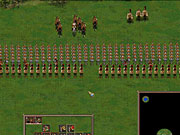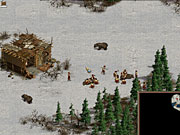American Conquest was released earlier this year, and even though it is a great strategy game, it met with little fanfare. Part of this could be blamed on its setting, as American Conquest takes place in the Americas during the 16th to 18th centuries. It's a time period that hasn't been heavily explored by real-time strategy games, which is rather unfortunate since the history is interesting. American Conquest: Fight Back is a stand-alone expansion pack that returns to the same setting. Unfortunately, it will probably be overlooked again. As before, however, the strategy, combat, and even history lessons are excellent.

The core mechanics of the game haven't changed, which is a good thing. The unique RTS elements found in American Conquest are a refreshing change of pace from other real-time strategy games, though they're reminiscent of Ensemble's Age of Empires series. As in most RTS games, there is resource gathering and base-building in American Conquest, but AC's got its own spin on them. Resources are practically infinite, but you need to protect your workers because the enemy can easily capture or kill them. You can build a base, but each subsequent building of the same type costs you more resources. So if you want a third fort for building more troops, expect to exponentially pay more resources for it than you did for the first one. The buildings themselves are relatively weak. They'll go down after receiving a few cannon volleys, or they'll catch ablaze after a few fire arrows. The enemy can also capture buildings by sending troops into them.
Both of these aspects mean that you need to protect your base from all angles. It's very easy to take advantage of an unprotected enemy flank by sending a cavalry into someone's base to capture their entire workforce. Fortunately, troops build quickly. You can have hundreds of pikemen, musketeers, archers, and other warriors in a matter of minutes. This leads to perhaps the greatest part about American Conquest: Fight Back. You can field armies of, literally, thousands of individual troops. The resulting battles can be spectacular, even if the graphics engine isn't exactly state of the art.
Trying to control thousands of troops in the 1700s was surely no easy task, and the same applies to Fight Back. If you expect to win any large-scale battles, you'll need to organize troops into formations by using officers, drummers, and standard bearers. Not only do they move and take orders as a single unit at that point, but the units get a combat and morale bonus. Morale is important because troops will run away and become uncontrollable if it drops.

The combat can be realistic and exciting, which may come as a surprise when you consider the weapons of the time. It's hard to suppress a smile when you see dozens of enemy warriors drop from a single volley of musket fire. Cannonballs ricochet off the ground and tear through formations like a hot knife through butter. If a lot of your troops die, nearby friendly units tuck their tails between their legs and run away. Generally, the game has everything you'd expect from combat of the actual time period.
Fight Back adds five new factions to American Conquest: Germany, Russia, Alaskan Haida, Portugal, and the Netherlands. As in American Conquest, differences between the similar factions are negligible beyond graphical origins. The real difference lies in the types of factions. There are two main types of factions: Native American and European. The Europeans employ military might with their cannons, guns, and massive warships. Native Americans don't have the same technological and military might as the European factions, but they can win by sheer force. Their units are cheap, and hundreds or archers will surely overrun a much smaller force of gunmen.
There are eight campaign missions that take plenty of time to complete. The missions have large maps and are rather challenging. The AI can be relentless, even on the easy setting. You'll fight battles in places like the Andes Mountains, the Yucatan Peninsula, and even the Alaskan Tundra. You'll play as familiar faces or as one of the three new factions--Germany, Russia, or Alaskan Haida.

Once again, there is huge replay value in Fight Back once you complete the campaign. There are 10 new single-player missions that are just as engaging as the campaign missions. There is also a new gameplay mode called "battlefield" that is fun and unique. It is a ladder system that places you in increasingly difficult situations. Battlefield doesn't have an economy like the other gameplay modes. Instead, it places two armies of different size and form on a battlefield. Either side can win the battle if it employs the proper strategies. You earn points based on how well you perform.
If you manage to get bored with all of this content, or you simply want to thrash a human opponent, you can play multiplayer games with up to seven people. Of course, you had better be prepared for some guesswork if you wish to use the game's master server because the registration forms are not in English. It's a glaring translation oversight, considering how you need English to find opponents online. Otherwise, you'd have to connect directly by IP addresses. Nevertheless, there are people playing Fight Back online, and the matches don't lag. There are plenty of options to choose from in multiplayer. You can play a standard base-building game, a deathmatch with tons of resources, or the new battlefield mode. There's something for every RTS fan in this game.
Some problems from American Conquest remain in Fight Back. Animals still pose a surprising threat to your troops. In real life, there's no way a bear would charge into a group of 100 pikemen, and there's definitely no way that bear would manage to kill a few of them before perishing. The real problem comes when the wildlife wanders into your base and starts killing your peasants. The unit AI is also still quirky. Units will often just run after enemies who come within eyesight. It would be nice if they, at least, walked back to their original positions. You'll also often see a lone warrior standing in the middle of a battlefield because he lost his target. There is a stand ground option, but you have to click it every time you move the formation.

Fight Back naturally uses the same engine as American Conquest. The game still looks very good overall. The game runs very well even when thousands of units are involved in a battle. The various terrains look great, ships make distorted reflections on the water, and each faction has a unique look. There are very minor details that add to the atmosphere, such as the men working the cannons who literally heave to make the thing move. Speaking of cannons, the game also has some great sounds. Cannon fire sends a boom though the air, and gun fire can emit an equally terrifying sound. The music can be repetitious, but overall it's pleasing to the ear.
Fight Back doesn't require the original American Conquest, which is good because there isn't a revolutionary change in the gameplay. The game's similarity to its predecessor isn't a bad thing because it offers a whole lot of content for only a $30 price tag. The downside is that its difficulty and sheer scale can turn off a casual player. If that doesn't daunt you, then by all means, pick up American Conquest: Fight Back. The strategy and history comes in the right combination for both fans of the first game and those who are interested in the time period.